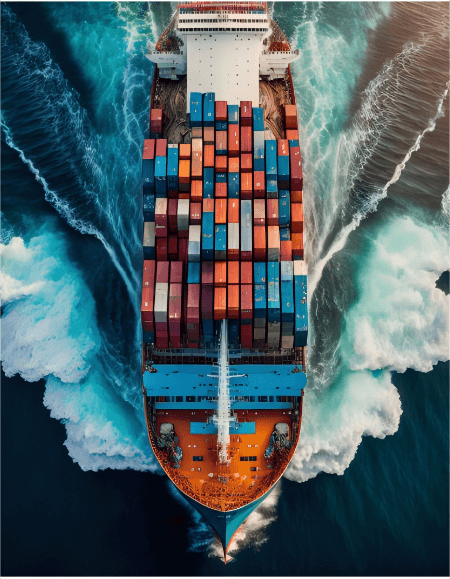- By TOP CHINA FREIGHT
- July 17, 2025
- Shipping
Top Reasons to Ship by Sea from China to Australia
Australia relies heavily on imports from China—its largest trading partner. Goods like electronics, furniture, construction materials, textiles, and consumer products are shipped regularly. Given the volume and distance, ocean shipping remains the most cost-effective and scalable transportation method between the two countries.
This article covers why ocean shipping is the best option for China–Australia trade, including typical costs, main sea routes and logistics solutions for smooth importing.

1. Cost-Effective for Bulk Cargo
Ocean freight is by far the most economical shipping method for large-volume or heavy goods. While air freight may deliver faster, its cost per kilogram is significantly higher. Ocean freight allows businesses to maximize shipping volume while keeping logistics budgets under control.
Typical Cost of Ocean Shipping from China to Australia
Ocean freight rates between China and Australia depend on cargo type, container size, service level, and seasonal fluctuations. Below is a general cost breakdown:
| Shipping Mode | Estimated Cost (USD) |
|---|---|
| LCL (Less than Container Load) | $60–$110 per CBM |
| FCL 20-foot Container | $1,000 – $2,000 |
| FCL 40-foot Container | $1,800 – $3,200 |
| Customs Clearance (both sides) | $100–$250 per shipment |
| Door-to-Door Delivery | Based on delivery region & cargo weight |
Prices fluctuate based on seasonality (e.g., before Christmas), fuel costs, and space availability.
2. Flexible Container Options
Whether you’re a small business or an enterprise, ocean shipping offers solutions tailored to your needs:
- FCL (Full Container Load): Exclusive use of a 20ft or 40ft container for bulk or high-volume cargo.
- LCL (Less-than-Container Load): Share a container and pay only for the space you use—ideal for smaller shipments.
- Reefer, Open-Top, Flat Rack Containers: For special goods like perishables, oversized machinery, or sensitive equipment.
3. Main Sea Route from China to Australia
Shipping routes between China and Australia are well-established and supported by frequent weekly sailings from major ports.
| Route Segment | Details |
|---|---|
| Departure Ports (China) | Shanghai, Shenzhen, Ningbo, Qingdao, Xiamen |
| Ocean Route | South China Sea ➜ Java Sea ➜ Timor Sea ➜ Coral Sea / Tasman Sea |
| Arrival Ports (Australia) | Sydney, Melbourne, Brisbane, Fremantle, Adelaide |
| Transit Time | Typically 12–25 days, depending on port combination and service type |
Example: Shenzhen ➜ Sydney = approx. 12–16 days
4. End-to-End Logistics Support
Working with an experienced freight forwarder ensures seamless coordination of your ocean shipment from the factory in China to your final delivery point in Australia.
| Logistics Stage | Services Provided |
|---|---|
| Pickup at Supplier | Inland trucking or container haulage from factory to port |
| Export Customs Clearance | HS code review, documentation, inspection handling |
| Booking & Port Handling | FCL or LCL space booking, container loading, bill of lading |
| Ocean Transport | Real-time tracking, vessel scheduling, transit updates |
| Import Customs in Australia | Quarantine checks, customs entry, duty & GST management |
| Delivery to Final Address | Trucking from port to warehouse, business, or retail location |
| Extra Services (Optional) | Warehousing, insurance, fumigation, palletization, consolidation |
Door-to-door and port-to-port options are available.
5. Sustainable & Scalable Shipping
Ocean shipping is significantly more energy-efficient than air freight, making it the more environmentally responsible choice. For businesses aiming to lower their carbon footprint while still moving large volumes, sea freight is the most sustainable solution.
And thanks to increasing automation at ports and smart logistics systems, ocean shipping is now faster and more flexible than ever before.
Need a Shipping Quote?
Click below to get a free, no-obligation quote from TJ China Freight.
We’ll respond within 24 hours with the best shipping options for your cargo.
FAQ
Q1: How long does ocean shipping take from China to Australia?
Transit times range from 12 to 25 days, depending on origin and destination ports.
Example: Ningbo ➜ Melbourne ≈ 14–18 days
Q2: Is ocean shipping cheaper than air freight?
Yes. For large or heavy shipments, sea freight can be 70–90% cheaper than air freight, though slower.
Q3: What are the main ports in Australia for imports?
- Sydney – New South Wales’ primary import hub
- Melbourne – Largest container port in Australia
- Brisbane – Serves Queensland
- Fremantle – Western Australia
- Adelaide – South Australia
Q4: What documents are needed to ship to Australia?
- Commercial Invoice
- Packing List
- Bill of Lading
- Certificate of Origin (if required)
- Import Declaration (Australia Customs)
- ABN (Australian Business Number) of the importer
Q5: Are there quarantine or biosecurity checks in Australia?
Yes. Australia has strict biosecurity laws. Items like wooden packaging, food products, and agricultural goods require quarantine inspection or pre-treatment.
Q6: What import taxes or duties apply in Australia?
- Import duty varies by product (many are duty-free under AUSFTA)
- GST (Goods & Services Tax) is 10% on most imports
A licensed customs broker can calculate and declare duties accurately.
